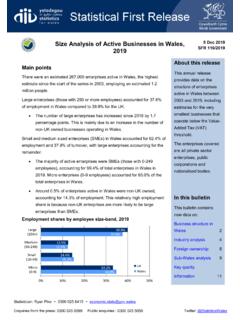Transcription of MICRO, SMALL AND MEDIUM SIZED ENTERPRISES …
1 EMNES Studies 3 DECEMBER 2017 micro , SMALL AND MEDIUM SIZED ENTERPRISES DEVELOPMENT IN EGYPT, JORDAN, MOROCCO & TUNISIA STRUCTURE, OBSTACLES AND POLICIES THE AUTHORS: Rym Ayadi and Emanuele Sessa (Editors) Hala Helmy El Said and Rana Hosni Ahmed (Egypt) Nooh Alshyab, Serena Sandri and Fuad Al Sheikh (Jordan) Mohamed Larbi Sidmou and Jad Allah Rami (Morocco) Rim Ben Ayed Mouelhi and Monia Ghazali Ferchichi (Tunisia) DISCLAIMER: The EMNES documents are produced with the financial assistance of the European Union within the context of the EU project Support to economic research, studies and dialogue of the Euro-Mediterranean Partnership under contract number ENPI/2014/354-488. The contents of EMNES documents are the sole responsibility of the authors and can under no circumstances be regarded as reflecting the position of the European Union.
2 MSMEs DEVELOPMENT IN THE SOUTHERN MEDITERRANEAN COUNTRIES EMNES Studies No 3 / December, 2017 EMNES Studies disseminate economic policy research to explore and assess the socio-economic drivers of the innovative, sustainable and inclusive development and growth models in the Mediterranean region. Available for free downloading from the EMNES website EMNES 2017 Page 2 of 88 ABOUT THIS STUDY This study is produced by the team of Research Area 2 on Private Sector Development and micro , SMALL and MEDIUM ENTERPRISES of the Euro-Mediterranean Network of Economic Studies (EMNES). The EMNES project is funded by a grant from the European Commission (ENPV/2014/354-488). The project s aim is to provide a renewed vision for socio-economic development in the Euro-Mediterranean region, mainly focusing on employment creation, social inclusion and sustainable development.
3 This study provides a snap shot of the current status quo in Egypt, Jordan, Morocco and Tunisia regarding the development of their private sectors, with a focus on micro , SMALL and MEDIUM ENTERPRISES . It will be used as a baseline for the definition of a robust research agenda that ultimately aims at providing sound recommendations for policy makers to improve developmental outcomes and, especially, the contribution of micro , SMALL and MEDIUM ENTERPRISES to employment creation. EMNES Research Area 1 team members who contributed to this report: Egypt: Hala Helmy El Said and Rana Hosni Ahmed Jordan: Nooh Alshyab, Serena Sandri and Fuad Al Sheikh Morocco: Mohamed Larbi Sidmou and Jad Allah Rami Tunisia: Rim Ben Ayed Mouelhi and Monia Ghazali Ferchichi Coordinators: Rym Ayadi and Emanuele Sessa The team wishes to thank Willem Pieter de Groen, Najat El Mekkaoui, Giorgia Giovannetti and Chahir Zaki for their valuable comments on this study.
4 The authors have sole responsibility for any claim or mistake contained in the study. MSMEs DEVELOPMENT IN THE SOUTHERN MEDITERRANEAN COUNTRIES EMNES Studies No 3 / December, 2017 EMNES Studies disseminate economic policy research to explore and assess the socio-economic drivers of the innovative, sustainable and inclusive development and growth models in the Mediterranean region. Available for free downloading from the EMNES website EMNES 2017 Page 3 of 88 TABLE OF CONTENTS EXECUTIVE SUMMARY .. 5 INTRODUCTION .. 8 MSME DEVELOPMENT IN SOUTHERN AND EASTERN 11 METHODOLOGY 14 MAIN FINDINGS 15 micro , SMALL AND MEDIUM ENTERPRISES IN EGYPT .. 24 STRUCTURE OF THE MSME SECTOR 24 MAIN CONSTRAINTS TO JOB CREATION IN THE EGYPTIAN MSME SECTOR 27 ACTORS AND POLICIES IN SUPPORT OF THE EGYPTIAN MSME SECTOR 31 micro SMALL AND MEDIUM ENTERPRISES IN JORDAN.
5 36 STRUCTURE OF THE MSME SECTOR 36 MAIN CONSTRAINTS TO JOB CREATION IN THE JORDANIAN MSME SECTOR 44 ACTORS AND POLICIES IN SUPPORT OF THE JORDANIAN MSME SECTOR 49 micro SMALL AND MEDIUM ENTERPRISES IN MOROCCO .. 53 STRUCTURE OF THE MSME SECTOR 53 MAIN CONSTRAINTS TO JOB CREATION IN THE MOROCCAN MSME SECTOR 57 ACTORS AND POLICIES IN SUPPORT OF THE MOROCCAN MSME SECTOR 61 micro SMALL AND MEDIUM ENTERPRISES IN TUNISIA .. 64 STRUCTURE OF THE MSME SECTOR 64 MAIN CONSTRAINTS TO JOB CREATION IN THE TUNISIAN MSME SECTOR 71 ACTORS AND POLICIES IN SUPPORT OF THE TUNISIAN MSME SECTOR 74 77 ANNEXES .. 81 REFERENCES .. 84 LIST OF TABLES TABLE 1: WORKING DEFINITIONS OF MSMES IN EGYPT, JORDAN, MOROCCO AND TUNISIA .. 11 TABLE 2: EGYPTIAN INSTITUTIONS INVOLVED IN THE IMPLEMENTATION OF SME POLICIES .. 32 TABLE 3: NET JOB CREATION BY GENDER, NATIONALITY AND SECTOR (IN %).
6 41 TABLE 4: DISTRIBUTION OF JORDANIAN EMPLOYEES BY ECONOMIC ACTIVITY .. 42 TABLE 5: MAIN INSTITUTIONS INVOLVED IN THE IMPLEMENTATION OF MSME POLICIES IN JORDAN .. 49 TABLE 6: PRIVATISATION OF STATE-OWNED ENTERPRISES IN JORDAN .. 50 TABLE 7: FDI AS A SHARE OF GDP IN JORDAN .. 51 TABLE 8: MINISTRIES INVOLVED IN SUPPORT TO MSMES IN MOROCCO .. 62 TABLE 9: TUNISIA RANKING AMONG 189 71 TABLE 10: TUNISIAN INSTITUTIONS INVOLVED IN THE IMPLEMENTATION OF MSME POLICIES .. 75 MSMEs DEVELOPMENT IN THE SOUTHERN MEDITERRANEAN COUNTRIES EMNES Studies No 3 / December, 2017 EMNES Studies disseminate economic policy research to explore and assess the socio-economic drivers of the innovative, sustainable and inclusive development and growth models in the Mediterranean region. Available for free downloading from the EMNES website EMNES 2017 Page 4 of 88 LIST OF FIGURES FIGURE 1: SECTORAL DISTRIBUTION OF MSMES IN EGYPT.
7 24 FIGURE 2: SHARES OF EXPORTING AND NON-EXPORTING FIRMS IN EGYPT .. 26 FIGURE 3: EGYPT S SCORE AND RANK IN INDICES OF REGULATORY EFFICIENCY .. 27 FIGURE 4: EGYPT S SCORE AND RANK IN INDICES OF MARKET OPENNESS .. 27 FIGURE 5: SHARE OF BANK AND NON-BANK FINANCING FOR PRIVATE INVESTMENT IN EGYPT .. 29 FIGURE 6: SHARE OF FIRMS WITH ACCESS TO BANK LOANS IN EGYPT .. 30 FIGURE 7: FIRMS WITH INTERNATIONALLY RECOGNISED QUALITY CERTIFICATION (%) .. 33 FIGURE 8: FIRM DISTRIBUTION BY SIZE IN JORDAN .. 37 FIGURE 9: AVERAGE SECTOR CONTRIBUTION TO JORDANIAN GDP AT CONSTANT PRICES BETWEEN 2004 AND 2014 . 37 FIGURE 10: ESTABLISHMENTS ENGAGED IN SOCIAL SECURITY BY ECONOMIC ACTIVITY IN 2014 .. 38 FIGURE 11: NUMBER OF ESTABLISHMENTS ENGAGED IN SOCIAL SECURITY BY ECONOMIC ACTIVITY IN JORDAN .. 39 FIGURE 12: ESTABLISHMENTS PER JORDANIAN GOVERNORATE IN %.
8 39 FIGURE 13: EMPLOYMENT CONTRIBUTION BY FIRM SIZE .. 40 FIGURE 14: AVERAGE OF EMPLOYEES BY ECONOMIC ACTIVITY BETWEEN 2003 AND 2013 .. 43 FIGURE 15: RANKING OF TOP BUSINESS ENVIRONMENT OBSTACLES FACING JORDANIAN FIRMS .. 46 FIGURE 16: AVERAGE SECTORAL DISTRIBUTION OF CREDIT FACILITIES BETWEEN 2004 AND 2014 .. 47 FIGURE 17: JORDANIAN EMPLOYEES BY EDUCATION AND WAGE CATEGORY .. 48 FIGURE 18: SECTORAL DISTRIBUTION OF VALUE ADDED BY FIRM SIZE IN MOROCCO .. 54 FIGURE 19: AGE DISTRIBUTION OF MOROCCAN FIRMS .. 55 FIGURE 20: NUMBER OF PERMANENT FULL-TIME WORKERS BY FIRM SIZE IN MOROCCO .. 56 FIGURE 21: EXPORT PERFORMANCE OF THE MOROCCAN MSME SECTOR .. 56 FIGURE 22: 2016 INDEX OF ECONOMIC FREEDOM FOR MOROCCO .. 57 FIGURE 23: MOROCCAN BUSINESSES EXPERIENCING CONSTRAINTS, AS HARD OR VERY HARD .. 58 FIGURE 24: RANKING OF MOROCCO AND BENCHMARK ECONOMIES ON EASE OF GETTING CREDIT.
9 59 FIGURE 25: SHARE OF INVESTMENT FINANCED BY BANKS IN MOROCCO .. 60 FIGURE 26: MOROCCAN FIRMS WITH BANK LOANS/LINE OF CREDIT BY SIZE .. 60 FIGURE 27: DISTRIBUTION OF TUNISIAN AND FOREIGN FIRMS BY SIZE IN 2014 .. 65 FIGURE 28: ENTRY OF FIRMS BY SIZE .. 65 FIGURE 29: EXIT OF FIRMS BY SIZE .. 66 FIGURE 30: MEAN TFP BY FIRM SIZE .. 67 FIGURE 31: DISTRIBUTION OF TUNISIAN FIRMS BY ACTIVITY AND BY SIZE IN 2014 .. 69 FIGURE 32: EMPLOYMENT SHARES OF TUNISIAN FIRMS IN 2014 BY SIZE .. 70 FIGURE 33: SECTORS SHARES IN TOTAL GOODS EXPORTS IN 2015 .. 70 FIGURE 34: TUNISIAN EXPORT PERFORMANCE BY FIRM SIZE IN 2015 .. 70 MSMEs DEVELOPMENT IN THE SOUTHERN MEDITERRANEAN COUNTRIES EMNES Studies No 3 / December, 2017 EMNES Studies disseminate economic policy research to explore and assess the socio-economic drivers of the innovative, sustainable and inclusive development and growth models in the Mediterranean region.
10 Available for free downloading from the EMNES website EMNES 2017 Page 5 of 88 EXECUTIVE SUMMARY Rym Ayadi and Emanuele Sessa gypt, Jordan, Morocco and Tunisia, among other Southern and Eastern Mediterranean Countries (SEMCs), stand out for their combination of rather large public sectors and persistently high unemployment rates. This poses the challenge for policy makers in downsizing the role of the state in the economy while enhancing job creation, whereas the policies advocated for the development of market-oriented economies by agenda-setting institutions, come together with important readjustments in terms of employment creation. In the current context of lacking economic opportunities for the region s population of educated yet unemployed youth, which is substantially increasing as a result of demographic trends, these readjustments will hardly be sustainable as countries cannot afford further instability.






